SEO + Digital Marketing + Journalism: Sometimes They Are Equal
3 worlds with 1 ruler; Content is king, residing in an inverted pyramid, and all is transparent

Most modern journalism gets funded by advertisers or sponsors. To keep the product as clean as possible from influence, editorial and sales departments almost always function apart from one another, often dubbed in the industry as the separation of church and state.
Over time, that has fostered misconceptions about the differences between techniques used to capture a story or a news event and those used to market or promote a product or a brand. However, specifically when it comes to the SEO side of digital marketing and advertising, there is enough shared DNA between the two that they should be considered, at least, as different breeds of the same species. Here are several examples of how fundamentals of journalism dictate contemporary online marketing.
EXTRA! EXTRA! NEWSPAPERS VERSUS SITE STRUCTURE
Over the past 25 years, as the Internet has grown from novelty to essential utility, the sources and amount of information out there has grown from what was once a tidal wave to settle into a global flood, with the water perpetually rising. To stay afloat, our human reliance on machine algorithms - whether it's a search engine, a multimedia app or a social media feed - has become both the life raft and the lighthouse. We type information into a search box and the bots then shine a beacon for us to find our way. Without that guidance, we drown.
One of the key features used to drive this search-and-find function is no different than it was in the days of dinosaurs and newspapers. Google is the mother of all algorithm lighthouses, and Google loves hierarchy; therefore, in general, YouTube, Facebook, Roku and Amazon also love hierarchy.
To get a solid sense of how to organize the information on your web site, whether for editorial or marketing needs, pick up the newspaper or the Yellow Pages. Imagine running them through a paper shredder, sifting the ribbons of paper all across your office and then trying to find a piece of information or a listing for a business on demand. Search bots were built to scour all of these shreds in our online world and bring them back together, for any user, at any place, at any time.
Back when newspapers were robust, a reader would find unique sections for national news, local news, business news, entertainment news, sports and so on. Further into the paper, the sequencing continues, in the local news section for Louisville, you might find Metro Government news, crime news, community and neighborhood announcements. Today, on a news outlet's site, you will find that same structure in the menu navigation.
MENU: HOME> NEWS> NATIONAL NEWS> REGIONAL NEWS> STATE NEWS> LOCAL NEWS>NEIGHBORHOOD NEWS
Think about how that reflects on business sites have been built to reflect that hierarchy, or to take part in modern-day Yellow Pages, advertising for select keywords on Google or Bing.
HOME PAGE > SERVICES > OPTIONS> PRICE PACKAGES> SALES PAGE
OR
AD CAMPAIGN> AD GROUP> AD / EXTENSIONS> VARIATIONS/ DEMOGRAPHICS AND LOCATION
The more specific you can be with the titling of these pages and sections, and the closer you keep the important ones to your home page, the heart of your brand, the better it should impact your SEO. In many ways, any web site can be mapped like a newspaper, allowing the bots to find and correctly classify your best and most urgent content.
THE SECRET OF THE (INVERTED) PYRAMIDS - CONTENT STRUCTURE
A standard metric taught in Journalism 101 has become a currency of sorts in the world of SEO: The inverted pyramid. For the uninitiated, this is the practice of taking the elements of a news story and organizing them so that the most important information is in the first paragraph, the next-highest-level info or supporting facts comes next and that process continues downward through the story, creating an upside-down triangle of importance if you map the story out.
The same is true when it comes to SEO. Even in a title tag, at the top of your HTML code, this traditionally gets shown in the blue links on Google results for your pages, as well as on the tab of your browser for a given page, the importance of its structure matters, even reading from left to right. For instance, a properly optimized title tag for a Shelbyville-based beauty salon named "Locks N Love" trying to rank locally for the keyword hair stylist would be: Hair Stylist - Shelbyville | Locks N Love. Further down the inverted pyramid of SEO, the H1 tag - or what effectively would be a headline in a newspaper - should echo the title tag's keywords in some regard, as should the content lower in the structure's body. This also applies when it comes to naming your image files and image captioning, as well.
Imagine a news story about a major drug bust printed in the paper and how a search engine algorithm might be built to guarantee retrieval of that story if a person was looking for that info. From the newsstand to the web, the process would go:
NEWSPAPER NAME (web site & branding) > LOCAL NEWS SECTION (title & menu) > DRUG BUST HEADLINE (H1 Tag) > Mugshots of suspects with names / captions related to drug bust > Story about drug bust.
Of course, digital information has no page limit, so you can go beyond all the news there is to fit in print, to paraphrase The New York Times, linking at the bottom of your story other related news of interest, further deepening what in the SEO world would be known as page authority.
When it comes to a business web page, this is one of those different-but-same events. So how would it apply to a web site for our fictional Locks N Love? A savvy site developer would create a keyword rich section, perhaps of hairstyles offered, along with photos and descriptions and even prices of each, following this hierarchy. In the worlds of local SEO and social SEO, similar content would be developed to provide brick-and-mortar-specific information on a Google My Business page and would be crafted to be visually engaging and inviting enough on Pinterest, Facebook and Instagram (and every other relevant island that you can fit it onto, in this ever-expanding tide) to spark engagement.
Social buzz and the freshness of content are increasingly important factors in feeding search-ranking algorithms. If your site is not generating compelling content and your competitor is, you very well could be miles behind in the marketing race.
THE SIN OF BAD SYNTAX
THIS IS A GREAT DEAL!!! DON'T WAIT!!! CLICK HERE!!! At the risk of angering the Google gods, I use these examples of bad marketing to also show an example of bad writing, period. Yellow Journalism, Supermarket Tabloids, Spam. Stay away from it. A simple command, yes, but how does a robot recognize a bad sentence? For starters, we have moved lightyears beyond the skill level of Clippy's office assistance in Microsoft Word.
As much as the worlds of journalism, digital marketing and SEO collide when it comes to best practices, rules of thumb also apply when it comes to critical mistakes in written content. Many things that are absolute no-no's in a newsroom also should not be done on a business web site or in online advertising, and Google's guide of best practices agree.
Strunk & White's canonical guide of proper writing, The Elements of Style is just as at home in a marketing agency as it is a newsroom, and its lessons apply in SEO just as well. The phrase above at the top of this section, 'click here,' is a perfect example. It's barred from Google Ads practices, because as Google guidelines spell out, you can ask a person to click anywhere without guaranteeing anything. (Insert the voice of a Seinfeldian comedian: 'Click here? Where's here? Where will here take me?) Generic phrases and lifeless calls to action say nothing about your brand or your product.
Just as Strunk & White warn against the use of proliferation of exclamation points ('Dinner was great!' versus, 'Halt!'), Google Ads guidelines ban excessive and incorrect punctuation, gibberish and generic ad text. Be specific to your brand. Be specific to your product and service. Be specific to your customer's expectations. As they say in the world of news reporting, get the name of the dog.
Use of emojis differ, but user beware. While you will not see them in a Google Ad, they're allowed in advertising on Facebook. As far as using them in print news, just no. But it's been tried. USA Today printed a sad-face emoji headline in 2015 and was widely panned on social media. Moral of that story: If you take such a risk, make sure it fits your brand and tone. If you're using icons of money bags to promote financial advice, for instance, you might as well use a few clown emojis, too.
Some grammatical hairs to be split are just that - and are not the type of hairs that a place like Locks N Love should worry about when it comes to online ad copy. For instance, the Oxford Comma: While the AP Stylebook long ago shrugged it off to its grave (all the news that's fit to print, saving one blot of ink at a time), there is no concrete standard in SEO on whether you should write 'one, two, and three' or if 'one, two and three' is preferable. Same with nuances like whether to capitalize Internet (you do), whether to spell out numbers or write numerals (always use numerals in headlines; write out one through nine in the body of a story; however, there is a rat's nest of caveats) or whether to use canceled or cancelled.
There are some things that a marketer will not bat an eye at that would make a newsroom copy editor lose sleep. Most of those technicalities are not technical enough to have SEO value, positive nor negative, but you should always keep your potential customer base in mind and how people write and speak, as it influences the words they use to search and ultimately the language associated with your brand.
SEO, DIGITAL MARKETING & JOURNALISM ALSO MERGE WHEN...
It's not only the core, tangible areas where we can take lessons from journalism and apply them to digital marketing strategy and SEO efforts. Ultimately the common thread between the three, and ultimately all forms of art and communication, is the human condition, a singular expression of feeling that resonates universally; one person experiences it, while any person can feel it. Captivate your audience with an amazing tale that they cannot resist sharing. Find ways to bring them into that story. The best brands evoke emotion, think Coca-Cola's Santa Claus and Polar Bears, A Coke and a Smile.
Also, remember truth in advertising. Stick to the facts. When it comes to First Amendment law, there are more protections for a sensational news story than there are for what is said or written in your advertising. Go no further than a law firm's web site to understand that THIS IS AN ADVERTISEMENT. Defending a business site as a news outlet in a libel case or a similar tort makes for a trip down a very deep rabbit hole that might be worth its own post on another day.
Finally, applying to all three realms of reporting-marketing-SEO, is transparency. While smoke and mirrors grab eyeballs, customers have to buy into the magic, lest they end up believing they were merely tricked. As information comes from even more places and angles, the water level rises and the tub expands to keep it all contained. Now more than ever people want integrity; they want trust; they want truth - whether in marketing or in journalism, and the programmatic gatekeepers that rank and order the merits of information will continuously be fed tasty new algorithms to ensure as best as possible that consumers find exactly what they seek.
Having an SEO expert that can bridge the gap between robot and human, and who can also deliver powerful content, can be the difference in sinking or swimming as we dive deeper into the 2020s. As always, we're happy to help you.
502ads Digital Marketing Articles & Tips











